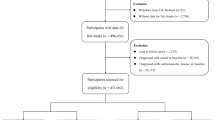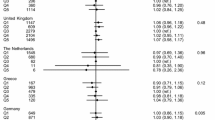Abstract
Purpose
To assess the relationship between dietary oily fish intake and all-cause mortality in a population of frequent fish consumers of Amerindian ancestry living in rural Ecuador.
Methods
Individuals aged ≥ 40 years enrolled in the prospective population-based Atahualpa Project cohort received annual questionnaires to estimate their dietary oily fish intake. Only fish served broiled or cooked in the soup were included for analysis. Poisson regression and Cox-proportional hazards models adjusted for demographics, education level and cardiovascular risk factors were obtained to estimate mortality risk according to the amount of oily fish intake stratified in tertiles.
Results
Analysis included 909 individuals (mean age: 55.1 ± 12.8 years) followed by a median of 7.5 ± 3 years. Mean oily fish intake was 9.4 ± 5.7 servings per week. A total of 142 (16%) individuals died during the follow-up. The mortality rate for individuals in the first tertile de oily fish intake (0.0–6.29 servings) was 2.87 per 100 person-years, which decreased to 1.78 for those in the third tertile (10.59–35.0 servings). An adjusted Cox-proportional hazards model showed that individuals allocated to the second (HR 0.61; 95% CI 0.41–0.92) and third (HR 0.60; 95% CI 0.40–0.91) tertiles of dietary oily fish intake had significantly lower mortality risk than those in the first tertile.
Conclusion
Sustained oily fish intake of more than six servings per week reduces mortality risk in middle-aged and older adults of Amerindian ancestry.

Similar content being viewed by others
Data availability
Aggregated data from this study are available upon reasonable request to the corresponding author.
References
Panagiotakos DB, Zeimbekis A, Boutziouka V, Economou M, Kourlaba G, Toutouzas P (2007) Long-term fish intake is associated with better lipid profile, arterial blood pressure, and blood glucose levels in elderly people from Mediterranean islands (MEDIS epidemiological study). Med Sci Monit 13(7):CR307-312
Zhang J, Wang C, Li L, Man Q, Meng L, Song P, Froyland L, Du ZY (2012) Dietary inclusion of salmon, herring and pompano as oily fish resources reduces CVD risk markers in dyslipidaemic middle-aged and elderly Chinese women. Br J Nutr 108(8):1455–1465. https://doi.org/10.1017/S0007114511006866
Gammelmark A, Nielsen MS, Bork CS, Lundbye-Christensen S, Tjonneland A, Overvad K, Schmidt EG (2016) Association of fish consumption and dietary intake of n-3 PUFA with myocardial infarction in a prospective Danish study. Br J Nutr 116(1):167–177. https://doi.org/10.1017/S000711451600180X
Nozaki S, Sawada N, Matsuoka YJ, Shikimoto R, Mimura M, Tsugane S (2021) Association between dietary fish and PUFA intake in midlife and dementia in later life: the JPHC Saku Mental Health Study. J Alzheimer Dis 79(3):1091–1104. https://doi.org/10.3233/JAD-191313
van Bussel BCT, Henry RMA, Schalkwijk CG, Ferreira I, Feskens EJM, Streppel MT, Smulders YM, Twisk JWR, Stehouwer CDA (2011) Fish consumption in health adults is associated with decreased circulating biomarkers of endothelial dysfunction and inflammation during a 6-year follow-up. J Nutr 141(9):1719–1725. https://doi.org/10.3945/jn.111.139733
Tousoulis D, Plastiras A, Siasos G, Oikonomou E, Verveniotis A, Kokkou K, Maniatis K, Gouliopoulos N, Miliou A, Paraskevopoulos T, Stefanadis C (2014) Omega-3 PUFAs improved endothelial function and arterial stiffness with a parallel antiinflamatory effect in adults with metabolic syndrome. Atherosclerosis 232(1):10–16. https://doi.org/10.1016/j.atherosclerosis.2013.10.014
Mori TA (2014) Omega-3 fatty acids and cardiovascular disease: epidemiology and effects on cardiometabolic risk factors. Food Funct 5(9):2004–2019. https://doi.org/10.1039/c4fo00393d
Weichselbaum E, Com S, Buttriss J, Spanner S (2013) Fish in the diet: a review. Nutrition Bull 38(2):128–177. https://doi.org/10.1111/nbu.12021
Ness AR, Whitley E, Burr ML, Elwood PC, Smith GD, Ebrahim S (1999) The long-term effect of advice to eat more fish on blood pressure in men with coronary disease: results from the diet and reinfarction trial. J Hum Hypertens 13(11):729–733. https://doi.org/10.1038/sj.jhh.1000913
Rhee JJ, Kim E, Buring JE, Kurth T (2017) Fish consumption, omega-3 fatty acids, and risk of cardiovascular disease. Am J Prev Med 52(1):10–19. https://doi.org/10.1016/j.amepre.2016.07.020
Bang HO, Dyerberg J, Nielsen AB (1971) Plasma lipid and lipoprotein pattern in Greenlandic west-coast Eskimos. Lancet 1(7719):1143–1145. https://doi.org/10.1016/s0140-6736(71)91658-8
Fodor JG, Helis E, Yazdekhasti N, Vohnout B (2014) “Fishing” for the origins of the “Eskimo and heart disease” story: facts or wishful thinking? Can J Cardiol 30(8):864–868. https://doi.org/10.1016/j.cjca.2014.04.007
Del Brutto OH, Mera RM, Gillman J, Castillo PR, Zambrano M, Ha J-E (2016) Dietary oily fish intake and blood pressure levels: a population-based study. J Clin Hypertens (Greenwich) 18(4):337–341. https://doi.org/10.1111/jch.12684
Del Brutto OH, Mera RM, Gillman J, Zambrano M, Ha J-E (2016) Oily fish intake and cognitive performance in community-dwelling older adults: the Atahualpa Project. J Community Health 41(1):82–86. https://doi.org/10.1007/s10900-015-0070-9
Del Brutto OH, Mera RM, Ha JE, Gillman J, Zambrano M, Castillo PR (2016) Dietary fish intake and sleep quality: a population-based study. Sleep Med 17:126–128. https://doi.org/10.1016/j.sleep.2015.09.021
Del Brutto OH, Recalde BY, Mera RM (2021) Dietary oily fish intake is inversely associated with severity of white matter hyperintensities of presumed vascular origin. A population-based study in frequent fish consumers of Amerindian ancestry. J Stroke Cerebrovasc Dis 30(6):105778. https://doi.org/10.1016/j.jstrokecerebrovasdis.2021.105778
Senftleber NK, Albrechtsen A, Lauritzen L, Larsen CL, Bjerregaard P, Diaz LJ, Ronn PF, Jorgensen ME (2020) Omega-3 fatty acids and risk of cardiovascular disease in Inuit: first prospective cohort study. Atherosclerosis 312:28–34. https://doi.org/10.1016/j.atherosclerosis.2020.08.032
Fumagalli M, Moltke I, Grarup N, Racimo F, Bjerregaard P, Jorgensen ME et al (2015) Greenlandic Inuit show genetic signatures of diet and climate adaptation. Science 349(6254):1343–1347. https://doi.org/10.1126/science.aab2319
de Goede J, Geleijnse JM, Boer JM, Kromhout D, Verschuren WM (2010) Marine (n-3) fatty acids, fish consumption, and the 10-year risk of fatal and nonfatal coronary heart disease in a large population of Dutch adults with low fish intake. J Nutr 140(5):1023–1028. https://doi.org/10.3945/jn.109.119271
Engeset D, Braaten T, Teucher B, Kuhn T, Bueno-de-Mesquita HB, Leenders M et al (2015) Fish consumption and mortality in the European Prospective Investigation into Cancer and Nutrition Cohort. Eur J Epidemiol 30(1):57–70. https://doi.org/10.1007/s10654-014-9966-4
Mohan D, Mente A, Dehghan M, Rangarajan S, O’Donell M, Hu W et al (2021) Associations of fish consumption with risk of cardiovascular disease and mortality among individuals with or without vascular disease from 58 countries. JAMA Intern Med 181(5):631–649. https://doi.org/10.1001/jamainternmed.2021.0036
Dewailly E, Blanchet C, Lemieux S, Sauvé L, Gingras S, Ayotte P, Holub BP (2001) n-3 fatty acids and cardiovascular disease risk factors among the Inuit of Nunavik. Am J Clin Nutr 74(4):464–473. https://doi.org/10.1093/ajcn/74.4.464
Dewailly E, Blanchet C, Gingras S, Lemieux S, Holub BJ (2002) Cardiovascular disease risk factors and n-3 fatty acid status in the adult population of James Bay Cree. Am J Clin Nutr 76(1):85–92. https://doi.org/10.1093/ajcn/76.1.85
McLaughlin J, Middaugh J, Boudreau D, Malcom G, Parry S, Tracy R, Newman W (2005) Adipose tissue triglyceride fatty acids and atherosclerosis in Alaska natives and non/natives. Atherosclerosis 181(2):353–362. https://doi.org/10.1016/j.atherosclerosis.2005.01.019
Del Brutto OH, Peñaherrera E, Ochoa E, Santamaría M, Zambrano M, Del Brutto VJ, Atahualpa Project Investigators (2014) Door-to-door survey of cardiovascular health, stroke, and ischemic heart disease in rural coastal Ecuador – the Atahualpa Project: methodology and operational definitions. Int J Stroke 9(3):367–371. https://doi.org/10.1111/ijs.12030
Castillo PR, Mera RM, Zambrano M, Del Brutto OH (2014) Population-based study of facial morphology and excessive daytime somnolence. Pathophysiology 21(4):289–292. https://doi.org/10.1016/j.pathophys.2014.06.001
von Elm E, Altman DG, Egger M, Pocock SJ, Gøtzsche PC, Vandenbroucke JP, Initiative STROBE (2007) The strengthening the reporting of observational studies in epidemiology (STROBE) statement: guidelines for reporting observational studies. Lancet 370(9596):1453–1457. https://doi.org/10.1016/S0140-6736(07)61602-X
Tollefson L, Cordle L (1986) Methylmercury in fish: a review of residue levels, fish consumption and regulatory actions in the United States. Environ Health Perspect 68:203–208. https://doi.org/10.1289/ehp.8668203
Lloyd-Jones D, Hong Y, Labarthe D, Mozaffarian D, Appel LJ, Van Horn L et al (2010) Defining and setting national goals for cardiovascular health promotion. The American Heart Association’s strategic impact goal through 2020 and beyond. Circulation 121(4):586–613. https://doi.org/10.1161/CIRCULATIONAHA.109.192703
Ahmad MI, Chevli PA, Barot H, Soliman EZ (2019) Interrelationships between American Heart Association’s life’s simple 7, ECG silent myocardial infarction, and cardiovascular mortality. J Am Heart Assoc 8(6):e011648. https://doi.org/10.1161/JAHA.118.011648
Commodore-Mensah Y, Mok Y, Gottesman RF, Kucharska-Newton A, Matsushita K, Palta P, Rosamond WD, Sarfo FS, Coresh J, Koton S (2022) Life’s Simple 7 at midlife and risk of recurrent cardiovascular disease and mortality after stroke: the ARIC study. J Stroke Cerebrovasc Dis 31(7):106486. https://doi.org/10.1016/j.jstrokecerebrovasdis.2022.106486
Del Brutto OH, Mera RM, Recalde BY, Rumbea DA, Sedler MJ (2021) Life’s simple 7 and all-cause mortality. A population-based prospective cohort study in middle-aged and older adults of Amerindian ancestry living in rural Ecuador. Prev Med Rep 25:101668. https://doi.org/10.1016/j.pmedr.2021.101668
Bang HO, Dyerberg J, Sinclair HM (1980) The composition of the Eskimo food in north western Greenland. Am J Clin Nutr 33(12):2657–2661. https://doi.org/10.1093/ajcn/33.12.2657
Amorin CEG, Nunes K, Meyer D, Comas D, Bortolini MC, Salzano FM, Hunemeier T (2017) Genetic signature of natural selection in first Americans. Proc Natl Acad Sci USA 114(9):2195–2199. https://doi.org/10.1073/pnas.1620541114
Willett WC, Sacks F, Trichopoulou A, Drescher G, Ferro-Luzzi A, Helsing E, Trichopoulos D (1995) Mediterranean diet pyramid: a cultural model for healthy eating. Am J Clin Nutr 61(Suppl 6):1402S-1406S. https://doi.org/10.1093/ajcn/61.6.1402S
Acknowledgements
We would like to acknowledge the field personnel of the Atahualpa Project Cohort for their valuable contribution to this study.
Funding
This study was partially supported by an unrestricted grant from Universidad Espiritu Santo-Ecuador, Samborondón, Ecuador.
Author information
Authors and Affiliations
Contributions
OHD: study conceptualization and design; OHD and MJS: wrote the manuscript; RMM: conducted the statistical analysis; BYR: data collection and analysis; DAR: project administration, study coordinator. All authors contributed to the critical review and editing of the manuscript for important intellectual content and approved the final manuscript.
Corresponding author
Ethics declarations
Conflict of interest
The authors declare no competing conflicts of interest to disclose.
Ethical approval
The study was approved by the Ethics Committee of Hospital-Clínica Kennedy, Guayaquil (FWA 00030727). All participants gave signed informed consent, including permission to use their data for research purposes.
Rights and permissions
Springer Nature or its licensor (e.g. a society or other partner) holds exclusive rights to this article under a publishing agreement with the author(s) or other rightsholder(s); author self-archiving of the accepted manuscript version of this article is solely governed by the terms of such publishing agreement and applicable law.
About this article
Cite this article
Del Brutto, O.H., Mera, R.M., Recalde, B.Y. et al. Dietary oily fish intake reduces the risk of all-cause mortality in frequent fish consumers of Amerindian ancestry living in coastal Ecuador: the Atahualpa project. Eur J Nutr 62, 1527–1533 (2023). https://doi.org/10.1007/s00394-023-03093-0
Received:
Accepted:
Published:
Issue Date:
DOI: https://doi.org/10.1007/s00394-023-03093-0




